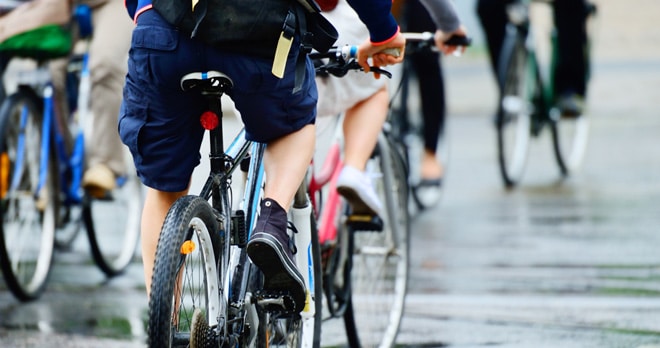Cycling safety: group riding

Two abreast
It’s a common assertion by drivers that cyclists shouldn’t ride two abreast. The message that we’re trying to spread is this: actually, in certain situations it can be safer for all involved to ride two abreast. The Highway Code’s Rule 66 states: ‘cyclists should never ride more than two abreast…’, giving clear guidance that two abreast is definitely acceptable.
Consider, for example, the situation where you have a group of six cyclists ahead of you in the road; if these cyclists ride in single file they are likely to take up at least the equivalent of six car lengths. Now the alternative; if these cyclists choose to cycle two abreast then the distance required to overtake them is almost halved meaning that you will be able to do so more quickly and thus spending less time on the opposite carriageway – safer for all concerned.
Additionally, cyclists often ride two abreast so they can chat to co-riders, making for a more enjoyable ride. This does not compromise on safety and is no different to sitting and talking to a front seat passenger in a car. Cycling side-by-side also allows cyclists to share information more easily, for example letting each other know a car is approaching and to pull into single file in appropriate circumstances. Cyclists riding together in this way learn from each other and members of cycling clubs are statistically much less likely to be involved in accidents than solo riders.
What is the guidance on overtaking?
The guidance for drivers on overtaking cyclists (and motorcyclists and horse riders) is that these vulnerable road users should be given at least as much room as when overtaking a car. In terms of the room required to overtake cyclists in single file or two abreast, it’s a minor adjustment. Where there is a large group (more than 10), they should really divide the group and leave a few metres gap between them to make life easier for drivers.
Cycling two abreast encourages drivers to overtake safely, and not attempt to overtake in the same lane as a group of cyclists. When cyclists ride single file, drivers often overtake too close or at the wrong moment, such as when there are cars approaching in the opposite lane. Cycling side-by-side encourages an overtaking driver to wait until there is room to pass safely over the centre-line and makes unsafe overtaking less likely.
When is single file preferable?
Cyclists should keep in mind that The Highway Code also states that they should ride single file on narrow or busy roads and while cycling round bends. Unfortunately, The Highway Code neglects to specify what is meant by “narrow”, “busy” or “bends”, so the law is unclear about just how narrow, busy or winding a road must be before riding single file becomes compulsory. In this situation common sense must prevail.
I am often instructed by cyclists injured following a collision with a vehicle that overtook them too closely.